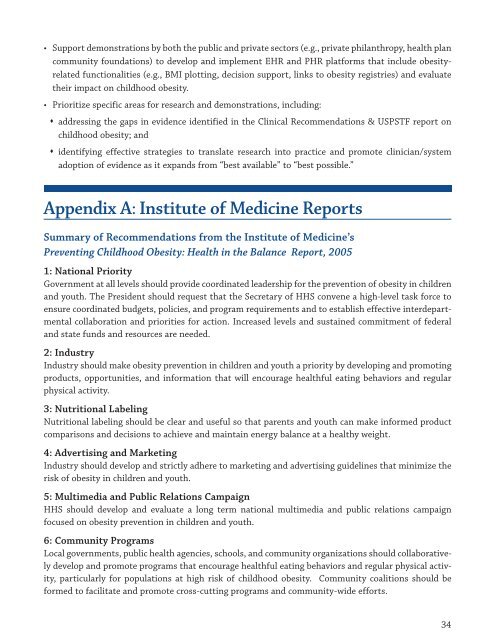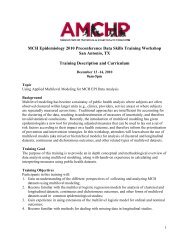Childhood Obesity: The Role of Health Policy - Association of ...
Childhood Obesity: The Role of Health Policy - Association of ...
Childhood Obesity: The Role of Health Policy - Association of ...
You also want an ePaper? Increase the reach of your titles
YUMPU automatically turns print PDFs into web optimized ePapers that Google loves.
• Support demonstrations by both the public and private sectors (e.g., private philanthropy, health plan<br />
community foundations) to develop and implement EHR and PHR platforms that include obesityrelated<br />
functionalities (e.g., BMI plotting, decision support, links to obesity registries) and evaluate<br />
their impact on childhood obesity.<br />
• Prioritize specific areas for research and demonstrations, including:<br />
� addressing the gaps in evidence identified in the Clinical Recommendations & USPSTF report on<br />
childhood obesity; and<br />
� identifying effective strategies to translate research into practice and promote clinician/system<br />
adoption <strong>of</strong> evidence as it expands from “best available” to “best possible.”<br />
Appendix A: Institute <strong>of</strong> Medicine Reports<br />
Summary <strong>of</strong> Recommendations from the Institute <strong>of</strong> Medicine’s<br />
Preventing <strong>Childhood</strong> <strong>Obesity</strong>: <strong>Health</strong> in the Balance Report, 2005<br />
1: National Priority<br />
Government at all levels should provide coordinated leadership for the prevention <strong>of</strong> obesity in children<br />
and youth. <strong>The</strong> President should request that the Secretary <strong>of</strong> HHS convene a high-level task force to<br />
ensure coordinated budgets, policies, and program requirements and to establish effective interdepartmental<br />
collaboration and priorities for action. Increased levels and sustained commitment <strong>of</strong> federal<br />
and state funds and resources are needed.<br />
2: Industry<br />
Industry should make obesity prevention in children and youth a priority by developing and promoting<br />
products, opportunities, and information that will encourage healthful eating behaviors and regular<br />
physical activity.<br />
3: Nutritional Labeling<br />
Nutritional labeling should be clear and useful so that parents and youth can make informed product<br />
comparisons and decisions to achieve and maintain energy balance at a healthy weight.<br />
4: Advertising and Marketing<br />
Industry should develop and strictly adhere to marketing and advertising guidelines that minimize the<br />
risk <strong>of</strong> obesity in children and youth.<br />
5: Multimedia and Public Relations Campaign<br />
HHS should develop and evaluate a long term national multimedia and public relations campaign<br />
focused on obesity prevention in children and youth.<br />
6: Community Programs<br />
Local governments, public health agencies, schools, and community organizations should collaboratively<br />
develop and promote programs that encourage healthful eating behaviors and regular physical activity,<br />
particularly for populations at high risk <strong>of</strong> childhood obesity. Community coalitions should be<br />
formed to facilitate and promote cross-cutting programs and community-wide efforts.<br />
34



